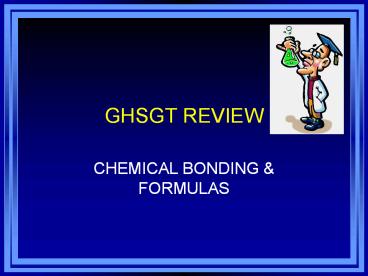GHSGT REVIEW - PowerPoint PPT Presentation
Title:
GHSGT REVIEW
Description:
Title: THE STRUCTURE OF MATTER Author: OFFICE Last modified by: OFFICE Created Date: 11/28/2005 1:58:54 AM Document presentation format: On-screen Show (4:3) – PowerPoint PPT presentation
Number of Views:87
Avg rating:3.0/5.0
Title: GHSGT REVIEW
1
GHSGT REVIEW
- CHEMICAL BONDING FORMULAS
2
(No Transcript)
3
What is a chemical bond?
- The attractive force that holds atoms or ions
together in a compound.
4
What is the goal when atoms bond?
- To obtain a full outer energy level
5
What is the octet rule?
- An atom will gain, lose or share electrons to get
8 electrons on the outermost energy level - Full outer energy level stable atom
6
What are two types of bonds that can occur
between atoms?
- Ionic
- Covalent
7
What is an ionic bond?
- A bond formed by atoms that have gained or lost
electrons
8
- Example F p 9 F1- p 9
- no 10 no 10
- e- 9 e- 10
- Na p 11 Na1 p 11
- no 12 no 12
- e- 11 e- 10
9
- The ionic compound formed is NaF (sodium
fluoride) - Na was attracted to F-
10
SODIUM CHLORIDE
11
What is a covalent bond?
- A bond formed when atoms share one or more pairs
of electrons
12
What happens to the electrons when a covalent
bond forms?
- Electrons in the outermost energy level are
shared between the two atoms - Shown using an electron dot diagrams.
13
COVALENT BOND
14
How can the type of bond between two atoms be
predicted?
- Metal and nonmetal ionic bond
- Nonmetal and nonmetal covalent bond
- Predict the following
- Mg and F ionic
- O and Cl covalent
- Zn and Zn metallic
15
What is a polyatomic ion?
- An ion made of two or more atoms that are
covalently bonded and that act like a single ion
usually forms ionic bonds with other atoms
16
NAME SYMBOL
Ammonium NH41
Acetate C2H3O2-1
Carbonate CO3-2
Chlorate ClO3-1
Hydroxide OH-1
Nitrate NO3-1
Phosphate PO4-3
Sulfate SO4-2
17
Compound Names and Formulas
18
What is an oxidation number?
- The number of electrons an atom needs to gain,
lose, or share when it forms a chemical bond - Pattern of oxidation numbers
- 1 2 3 or -4 -3 -2
-1 0 - Ex Na 1 Cl -1
- Mg 2 O -2
19
How can oxidation numbers be used to write
chemical formulas for ionic compounds?
- Write the symbols of the atoms
- Write the correct oxidation numbers to the right
of each symbol - If the oxidation numbers do not add up to zero,
write the oxidation number of each atoms as a
subscript of the opposite symbol (the symbol of
the atom with the positive oxidation number is
written 1st in the formula)
20
- This is called the criss-cross method
- Ex Lithium and fluorine
- Li1 F1- LiF
- Magnesium and chlorine
- Mg2 Cl1- MgCl2
21
If the compound is covalent, what rules are
followed to write the formula?
- Prefixes will be used in the name of the formula
so just write the symbols of the elements and use
the prefix (di, tri, etc.) as the subscript. DO
NOT USE OXIDATION NUMBERS TO WRITE THE FORMULAS
FOR COVALENT COMPOUNDS!!! DO NOT USE THE
CRISS-CROSS METHOD!!!!
22
- Ex carbon dioxide CO2
- carbon tetrachloride CCl4
23
What are the common prefixes?
- 1 mono-
- 2 di-
- 3 tri-
- 4 tetra-
- 5 penta-
- 6 hexa-
- 7 hepta-
- 8 octa-
- 9 nona-
- 10 deca-
24
What are the rules for naming compounds?
- If the compound is a metal and a nonmetal, change
the ending of the nonmetal to ide - Ex NaBr sodium bromide
- AlCl3 aluminum chloride
25
- If the compound has a polyatomic ion, use the
name of the polyatomic ion in the name of the
compound. - Ex AgNO3 silver nitrate
- Na2CO3 sodium carbonate
26
- If the compound is 2 nonmetals, use the prefixes
such as di, tri, etc. of the subscript in the
name - - also change the ending to ide
- Ex SiO2 silicon dioxide
- NF3 nitrogen trifluoride































